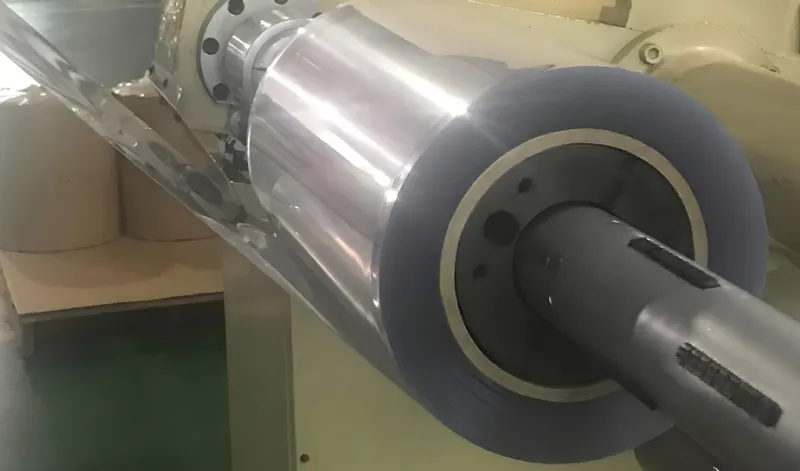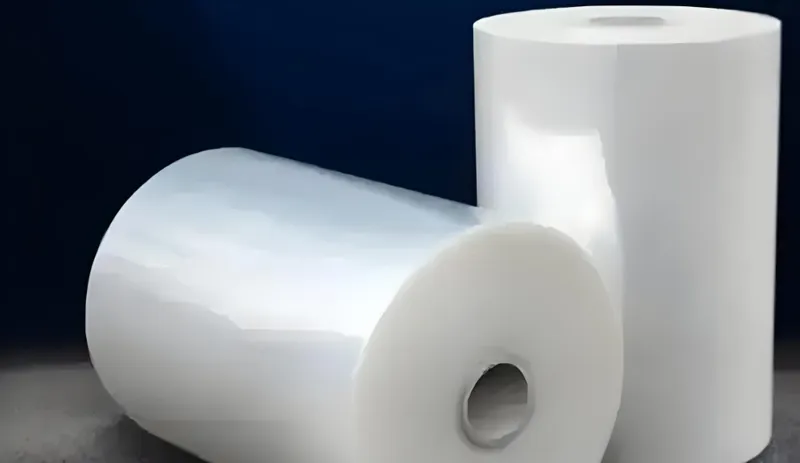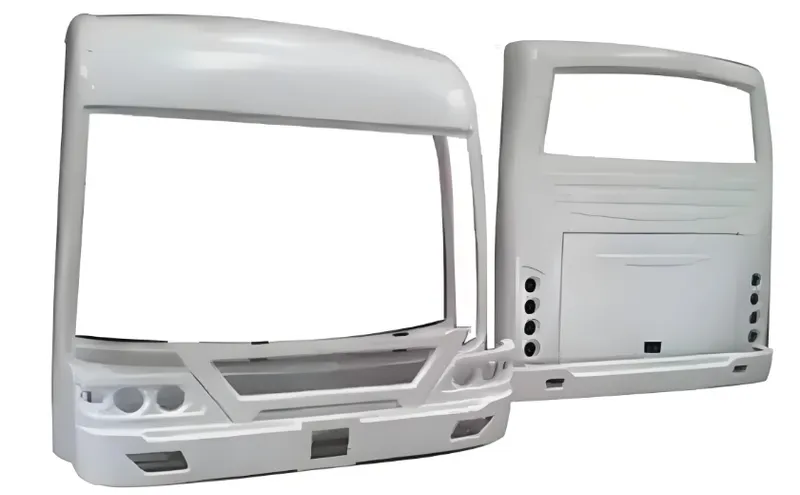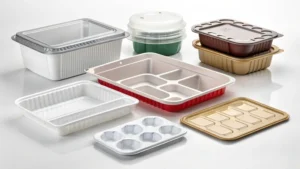
La formatura sottovuoto multimateriale è una tecnica di produzione avanzata che integra più materiali per produrre articoli con caratteristiche superiori. Utilizzando i principi fondamentali della formatura sottovuoto, questo metodo facilita la creazione di prodotti leggeri, resistenti e adattabili, adatti a una vasta gamma di applicazioni. Dalle soluzioni di imballaggio ai componenti automobilistici, formatura sottovuoto multimateriale1 offre ai produttori una via economica ed efficiente per innovare e migliorare le loro offerte.
La formatura sottovuoto multimateriale sfrutta più materiali termoplastici per realizzare prodotti con caratteristiche avanzate, offrendo soluzioni economicamente vantaggiose nei settori dell'imballaggio, automobilistico e medicale.
Conoscere le sfumature della formatura sottovuoto multimateriale e le sue applicazioni è essenziale per sfruttarne i vantaggi nel vostro settore. Approfondite la conoscenza di come i vari materiali e i parametri di processo influenzino le proprietà e gli usi dei prodotti finali.
La formatura sottovuoto multimateriale riduce i costi dei materiali nella produzione.Vero
Combinando materiali con proprietà specifiche, i produttori possono ottimizzare l'uso dei materiali e ridurre gli scarti, abbassando i costi complessivi.
La formatura sottovuoto multimateriale è utilizzata solo nelle applicazioni di imballaggio.Falso
Pur essendo prevalente nel settore degli imballaggi, la sua versatilità si estende anche all'industria automobilistica, medica e dei beni di consumo.
- 1. Quali sono i materiali più comuni utilizzati nella formatura sottovuoto multimateriale?
- 2. Quali sono le fasi del processo di formatura sottovuoto multimateriale?
- 3. Quali sono i fattori chiave del processo di formatura sottovuoto multimateriale?
- 4. Quali sono le applicazioni della formatura sottovuoto multimateriale?
- 5. Quali sono le differenze tra la formatura sotto vuoto multimateriale e la formatura sotto vuoto monomateriale?
- 6. Conclusione
Quali sono i materiali più comuni utilizzati nella formatura sottovuoto multimateriale?
La scelta dei materiali nella formatura sottovuoto multimateriale è fondamentale per le industrie che richiedono prodotti leggeri, durevoli e funzionali, migliorando sia l'efficienza che il rapporto costo-efficacia.

I materiali più comuni sono il polipropilene (PP), il polietilene ad alta densità (HDPE), il policarbonato (PC), il polimetilmetacrilato (PMMA), il polistirene (PS), il cloruro di polivinile (PVC), i compositi e le opzioni biodegradabili come l'acido polilattico (PLA).
| Tipo di materiale | Proprietà chiave | Applicazioni |
|---|---|---|
| Polipropilene (PP)2 | Resistenza chimica, durata | Imballaggio, automotive |
| Polietilene ad alta densità (HDPE) | Resistenza agli urti, flessibilità | Automotive, beni di consumo |
| Policarbonato (PC) | Trasparenza, resistenza al calore | Dispositivi medici, elettronica |
| Acido polilattico (PLA)3 | Biodegradabilità, sostenibilità | Imballaggio ecologico |
Polipropilene (PP)
Il PP è favorito nella formatura sottovuoto multimateriale per la sua robusta resistenza chimica e la sua durata. Viene spesso abbinato ad altri materiali per produrre imballaggi che richiedono resistenza e flessibilità, come i contenitori per alimenti con una maggiore durata di conservazione grazie all'aggiunta di strati barriera.
Polietilene ad alta densità (HDPE)
L'HDPE vanta un'elevata resistenza agli urti e flessibilità, che lo rendono un elemento fondamentale per i componenti automobilistici e i beni di consumo. Nelle configurazioni multimateriale, può essere combinato con l'ABS per migliorare la rigidità e l'estetica.

Policarbonato (PC)
Grazie alla sua trasparenza e resistenza al calore, il PC è ideale per i dispositivi medici ed elettronici. Se stratificato con PMMA, migliora la resistenza ai graffi e la chiarezza ottica, aumentando la sua utilità.
Acido polilattico (PLA)
PLA, un opzione biodegradabile4Il PET sta guadagnando terreno nell'ambito degli imballaggi sostenibili. Se combinato con materiali come il PET, offre prodotti ecologici con proprietà barriera superiori.
L'acido polilattico (PLA) è un materiale fondamentale per gli imballaggi sostenibili.Vero
La biodegradabilità del PLA consente di abbinarlo ad altri materiali per ottenere soluzioni di imballaggio ecologiche.
La formatura sottovuoto multimateriale non è adatta a tutti i settori, nonostante i suoi vantaggi.Vero
Alcuni settori industriali possono richiedere materiali con proprietà come l'estrema resistenza al calore che la formatura sottovuoto multimateriale non può soddisfare pienamente.
Quali sono le fasi del processo di formatura sottovuoto multimateriale?
Il processo di formatura sottovuoto multimateriale è utile per realizzare prodotti leggeri e durevoli, integrando più materiali durante la fase di formatura.
Il processo comprende la selezione dei materiali, la preparazione delle lastre, la progettazione degli stampi, il riscaldamento, la formatura, il raffreddamento e la rifilatura, servendo settori come l'imballaggio, l'automotive e il medicale con la sua versatilità ed efficienza in termini di costi.

Selezione del materiale
Selezionare i materiali compatibili in base agli attributi desiderati (ad esempio, PP per la resistenza, EVOH per le barriere), garantendo una forte adesione tra gli strati per evitare la delaminazione.
Preparazione del foglio
Utilizzare lastre coestruse multistrato o incollare lastre separate secondo le necessità. Le ricerche indicano che è possibile coestrudere efficacemente fino a sette strati.
Progettazione di stampi
Stampi artigianali con angoli di sformo (minimo 3°), fori di ventilazione e caratteristiche adatte al flusso multimateriale per una formatura ottimale.
Riscaldamento
Riscaldare uniformemente la lastra multistrato alla temperatura di formatura, evitando la delaminazione grazie a un preciso controllo della temperatura.
Formazione
Applicare la pressione del vuoto per modellare la lastra sullo stampo. Le forme complesse possono richiedere un'assistenza meccanica o una formatura a pressione.

Raffreddamento
Raffreddare il pezzo formato sullo stampo per solidificare la forma e mantenere l'integrità strutturale.
Rifinitura e rifinitura
Rimuovere il materiale in eccesso ed eseguire operazioni secondarie come il taglio o l'assemblaggio per finalizzare il prodotto.
La formatura sottovuoto multimateriale produce sempre una struttura uniforme.Falso
L'uniformità dipende da fattori quali la compatibilità dei materiali e le condizioni di processo, che possono variare.
La formatura sottovuoto multimateriale riduce l'uso di materiale senza compromettere la resistenza.Vero
Miscelando materiali con proprietà mirate, crea prodotti leggeri ma robusti.
Quali sono i fattori chiave del processo di formatura sottovuoto multimateriale?
Questo processo è fondamentale per realizzare prodotti migliorati grazie alla fusione di più materiali durante la formatura.
I fattori chiave includono compatibilità dei materiali5, parametri di processo6e la progettazione dello stampo, che determinano la struttura, la durata e le prestazioni del prodotto finale.

Compatibilità dei materiali
I materiali devono avere punti di fusione, coefficienti di espansione termica e proprietà meccaniche simili per garantire il successo della formatura e prevenire la delaminazione.
Parametri di processo
I parametri critici come la temperatura di riscaldamento, la pressione del vuoto e il tempo di raffreddamento devono essere gestiti meticolosamente per ottenere le qualità desiderate del prodotto.
Progettazione di stampi
Gli stampi richiedono angoli di sformo, ventilazione e caratteristiche adeguate per supportare il flusso multimateriale, garantendo una facile sformatura e risultati di alta qualità.
La scelta del materiale è fondamentale per determinare le caratteristiche del prodotto.Vero
Le interazioni uniche tra i materiali modellano direttamente proprietà come la resistenza e la flessibilità.
Tutti i processi di formatura sottovuoto multimateriale utilizzano gli stessi parametri.Falso
I parametri vengono regolati in base alle scelte dei materiali e alle specifiche del prodotto desiderato.
Quali sono le applicazioni della formatura sottovuoto multimateriale?
La formatura sottovuoto multimateriale offre soluzioni produttive versatili, migliorando i prodotti in diversi settori.
Serve imballaggio7I settori automobilistico, medico e dei beni di consumo combinano le proprietà dei materiali per aumentare la funzionalità e ridurre i costi.

Imballaggio
Nel settore dell'imballaggio, realizza contenitori con proprietà barriera per la conservazione degli alimenti, come il PP stratificato con EVOH per la resistenza all'umidità e all'ossigeno.
Automotive
Per automobilistico8 produce pannelli per interni che combinano strati estetici e funzionali, come l'HDPE con l'ABS per la resistenza agli urti e la finitura.

Medico
Il settore medicale lo impiega per dispositivi sterili e trasparenti come i vassoi chirurgici, spesso combinando PC e PMMA per ottenere chiarezza e durata.
Beni di consumo
Le confezioni in blister per i beni di consumo sfruttano la rigidità e la flessibilità, utilizzando materiali come il PVC e il PET per la protezione e l'attrattiva.
La formatura sottovuoto multimateriale riduce i costi dei materiali nella produzione.Vero
L'uso ottimizzato dei materiali minimizza gli scarti, riducendo le spese di produzione.
La formatura sottovuoto multimateriale è utilizzata solo nell'industria dell'imballaggio.Falso
Le sue applicazioni spaziano dai settori automobilistico, medicale e dei beni di consumo, compresi pannelli e vassoi.
Quali sono le differenze tra la formatura sotto vuoto multimateriale e la formatura sotto vuoto monomateriale?
Complessità del processo
La formatura sottovuoto multimateriale richiede l'integrazione di più materiali, con un'attenta selezione e controllo della compatibilità e dell'adesione. La formatura sottovuoto monomateriale è più semplice e utilizza un solo tipo di materiale.

Caratteristiche del prodotto
La formatura multimateriale migliora i prodotti unendo proprietà come la resistenza e la flessibilità, mentre formatura monomateriale9 è vincolato dagli attributi di un singolo materiale.
Costi ed efficienza
La formatura multimateriale offre risparmio sui costi nelle piccole e medie tirature10 grazie ai minori costi di attrezzaggio, anche se i costi dei materiali possono aumentare. La formatura monomateriale può avere costi di materiale più bassi, ma spese di attrezzaggio più elevate per le grandi tirature.

Conclusione
La formatura sottovuoto multimateriale si distingue come una tecnica di produzione versatile che realizza prodotti migliori combinando più materiali. Grazie alla selezione strategica dei materiali, alla progettazione degli stampi e al controllo dei parametri, si ottengono soluzioni leggere, durevoli e convenienti in diversi settori. Con l'aumento delle esigenze di innovazione e sostenibilità, questo metodo consente ai produttori di essere all'avanguardia.
-
Esplorate questo link per ottenere una comprensione completa della formatura sottovuoto multimateriale e delle sue diverse applicazioni nei vari settori. ↩
-
Scoprite i vantaggi del polipropilene (PP) nella produzione, in particolare la sua durata e la sua resistenza chimica, fondamentali per diverse applicazioni. ↩
-
Scoprite come l'acido polilattico (PLA) sta rivoluzionando le soluzioni di imballaggio sostenibili e i suoi benefici per l'ambiente. ↩
-
Scoprite i vantaggi dei materiali biodegradabili negli imballaggi, promuovendo la sostenibilità e la responsabilità ambientale. ↩
-
Scoprite il ruolo critico della compatibilità dei materiali per garantire il successo della formatura sottovuoto e la durata del prodotto. ↩
-
Scoprite i parametri di processo essenziali che influenzano la qualità e le prestazioni dei prodotti formati sottovuoto. ↩
-
Scoprite come la formatura sottovuoto multimateriale rivoluziona l'imballaggio, migliorando le proprietà barriera e preservando la qualità degli alimenti. ↩
-
Scoprite l'impatto della formatura sottovuoto multimateriale sul design automobilistico, con particolare attenzione all'estetica e alla funzionalità dei pannelli interni. ↩
-
Scoprite le differenze tra la formatura monomateriale e multimateriale per comprenderne i vantaggi e le applicazioni. ↩
-
Scoprite come le piccole e medie tirature possono portare a significativi risparmi sui costi dei processi produttivi, soprattutto con le tecniche multimateriale. ↩







